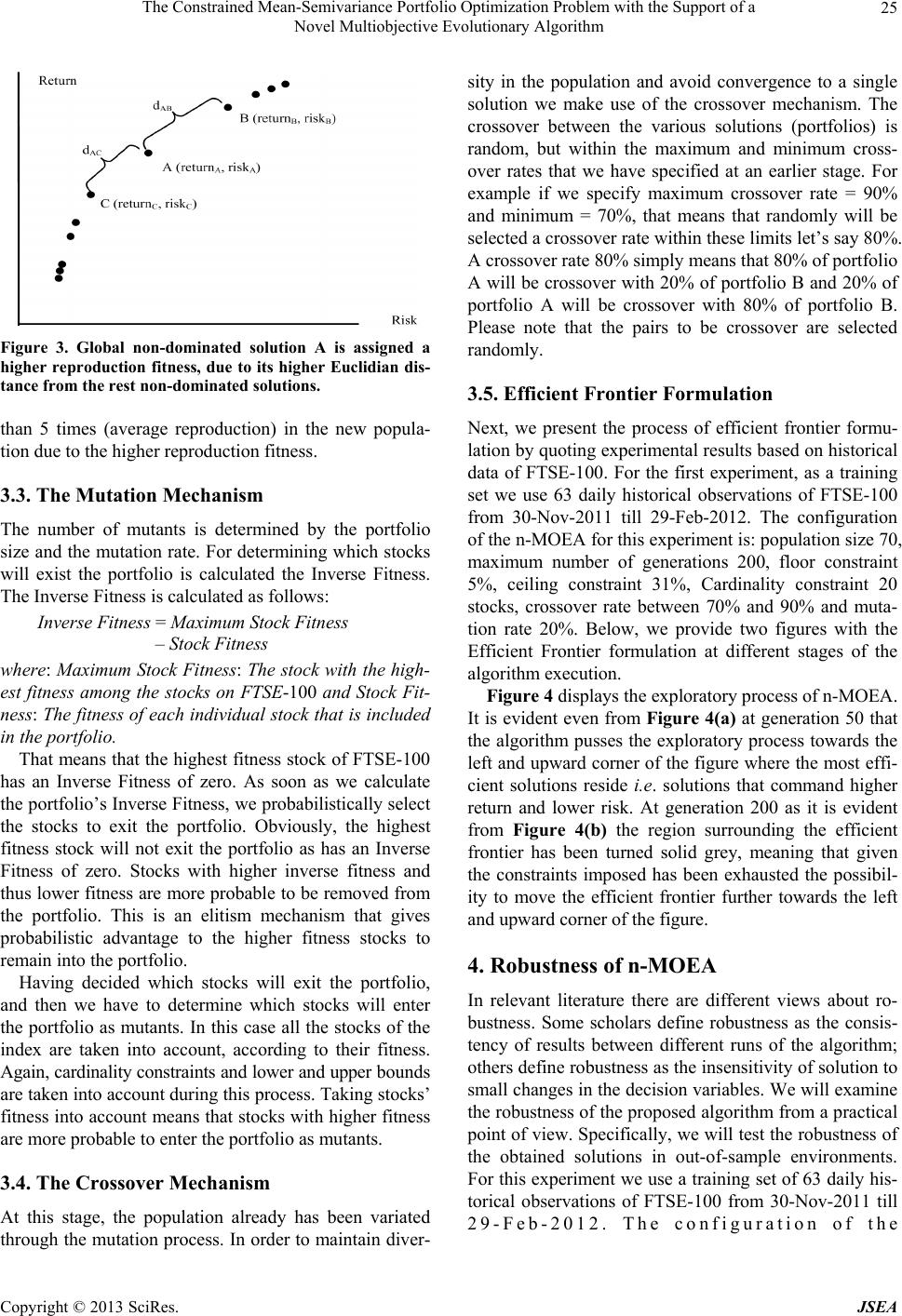
The Constrained Mean-Semivariance Portfolio Optimization Problem with the Support of a
Novel Multiobjective Evolutionary Algorithm
Copyright © 2013 SciRes. JSEA
25
Figure 3. Global non-dominated solution A is assigned a
higher reproduction fitness, due to its higher Euclidian dis-
tance from the rest non-dominated solutions.
than 5 times (average reproduction) in the new popula-
tion due to the higher reproduction fitness.
3.3. The Mutation Mechanism
The number of mutants is determined by the portfolio
size and the mutation rate. For determining which stocks
will exist the portfolio is calculated the Inverse Fitness.
The Inverse Fitness is calculated as follows:
Inverse Fitness = Maximum Stock Fitness
– Stock Fitness
where: Maximum Stock Fitness: The stock with the high-
est fitness among the stocks on FTSE-100 and Stock Fit-
ness: The fitness of each individual stock that is included
in the portfolio.
That means that the highest fitness stock of FTSE-100
has an Inverse Fitness of zero. As soon as we calculate
the portfolio’s Inverse Fitness, we probabilistically select
the stocks to exit the portfolio. Obviously, the highest
fitness stock will not exit the portfolio as has an Inverse
Fitness of zero. Stocks with higher inverse fitness and
thus lower fitness are more probable to be removed from
the portfolio. This is an elitism mechanism that gives
probabilistic advantage to the higher fitness stocks to
remain into the portfolio.
Having decided which stocks will exit the portfolio,
and then we have to determine which stocks will enter
the portfolio as mutants. In this case all the stocks of the
index are taken into account, according to their fitness.
Again, cardinality constraints and lower and upper b ou nd s
are taken into account during this process. Taking stocks’
fitness into account means that stocks with higher fitness
are more probable to enter the portfolio as mutants.
3.4. The Crossover Mechanism
At this stage, the population already has been variated
through the mutation process. In order to maintain diver-
sity in the population and avoid convergence to a single
solution we make use of the crossover mechanism. The
crossover between the various solutions (portfolios) is
random, but within the maximum and minimum cross-
over rates that we have specified at an earlier stage. For
example if we specify maximum crossover rate = 90%
and minimum = 70%, that means that randomly will be
selected a crossover rate within these limits let’s say 80%.
A crossover rate 80% simply means that 80% of portfolio
A will be crossover with 20% of portfolio B and 20% of
portfolio A will be crossover with 80% of portfolio B.
Please note that the pairs to be crossover are selected
randomly.
3.5. Efficient Frontier Formulation
Next, we present the process of efficient frontier formu-
lation by quoting experimental results based on historical
data of FTSE-100. For the first experiment, as a training
set we use 63 daily historical observations of FTSE-100
from 30-Nov-2011 till 29-Feb-2012. The configuration
of the n-MOEA for this experiment is: population size 70,
maximum number of generations 200, floor constraint
5%, ceiling constraint 31%, Cardinality constraint 20
stocks, crossover rate between 70% and 90% and muta-
tion rate 20%. Below, we provide two figures with the
Efficient Frontier formulation at different stages of the
algorithm execution.
Figure 4 displays the exploratory process of n-MOEA.
It is evident even from Figure 4(a) at generation 50 that
the algorithm pusses the exploratory process towards the
left and upward corn er of the figure where the most effi-
cient solutions reside i.e. solutions that command higher
return and lower risk. At generation 200 as it is evident
from Figure 4(b) the region surrounding the efficient
frontier has been turned solid grey, meaning that given
the constraints imposed has been exhausted the possibil-
ity to move the efficient frontier further towards the left
and upward corner of the figure.
4. Robustness of n-MOEA
In relevant literature there are different views about ro-
bustness. Some scholars define robustness as the consis-
tency of results between different runs of the algorithm;
others define robustness as the insensitivity of solution to
small changes in the decision variables. We will examine
the robustness of the proposed algorithm from a practical
point of view. Specifically, we will test the robustness of
the obtained solutions in out-of-sample environments.
For this experiment we use a training set of 63 daily his-
torical observations of FTSE-100 from 30-Nov-2011 till
29-Feb-2012. The configuration of the